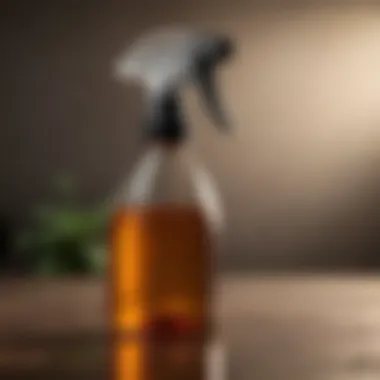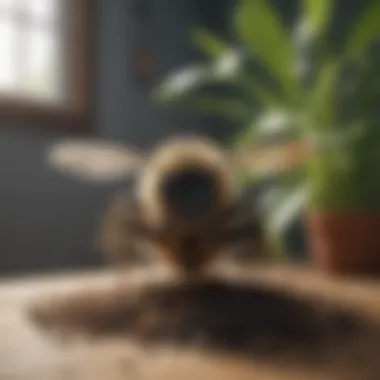Crafting an Effective Homemade Bee Killer Spray


Intro
In recent years, many homeowners and gardening enthusiasts have shown increased interest in pest control solutions that they can create on their own. The idea of crafting a homemade bee killer spray attracts those trying to manage pesky insects in their gardens or around their homes. However, it raises significant ethical considerations, particularly regarding our impact on bee populations. Understanding how to create such solutions effectively, while maintaining environmental awareness, is essential. This article will guide readers through the formulation of homemade bee killer sprays, exploring necessary ingredients, preparation methods, and responsible usage.
Creating a natural pest control solution starts with recognizing the need for such interventions. While bees are crucial for pollination and maintaining biodiversity, certain situations may require controlling their presence, particularly in close proximity to human habitats. Therefore, a balance must be struck between effective pest control and ecological responsibility.
As we navigate through the subsequent sections, expect to discover insights into proper techniques for spray preparation, suitable substances, and safety measures. We will also address the ethical implications of using these sprays in gardens and yards. This comprehensive understanding is not just for personal use but stresses the importance of respecting and protecting our environment.
Preamble to Homemade Bee Killer Spray
Homemade bee killer sprays have gained attention for their role in pest management. They offer a practical solution for individuals dealing with unwanted bee infestations. Understanding how to craft these sprays is crucial, especially for homeowners and gardening enthusiasts. This article discusses the necessity of creating such sprays, the ingredients that can be used, and the methods of preparation. It also addresses important safety considerations and ethical implications of using these sprays.
Why Consider Homemade Solutions
Many people opt for homemade solutions to pest control for several reasons. First, these sprays often utilize common household items, which can reduce costs. Commercial bee sprays tend to be expensive and may contain harsh chemicals. Homemade sprays present a more natural alternative. Furthermore, some commercial products may not be effective against all types of bees, leading users to seek tailored solutions.
Homemade solutions also empower individuals. They allow for control over what goes into the spray, making it easier to avoid harmful components. Additionally, crafting your own spray ensures that you can adapt recipes to target specific pests effectively. When one understands the specific mixture and its application, it significantly enhances the chances of successful pest control.
Understanding Your Target Pests
To effectively manage bee populations, it's essential to understand the types of bees you are dealing with. Not all bees are harmful; many play a role in pollination and contribute to ecological balance. Honeybees, bumblebees, and wasps are common types found in residential areas.
Honeybees are generally not aggressive unless provoked. Their primary function is pollination, which is vital for many plants. On the other hand, wasps can be more aggressive and may nest in close proximity to human activity. Identifying these differences helps in making informed decisions about pest management without causing unnecessary harm to beneficial species.
A careful approach in identifying your target pests is necessary before applying any homemade bee killer sprays. Proper understanding will guide you in selecting the right ingredients and application methods, ensuring that you achieve effective pest control while considering the ecological implications.
Ingredients for Bee Killer Spray
When addressing the issue of bee control, the ingredients employed in homemade bee killer sprays are paramount. Selecting the right components not only enhances the effectiveness of the spray but also ensures a safer application for both the user and the surrounding environment. Homemade solutions can eliminate bees without resorting to harsh chemicals. This addresses pest problems while being mindful of ecological impacts. Various ingredients come from everyday household items or natural sources, providing effective means for pest control.
Common Household Items
Dish Soap
Dish soap is a key component in many homemade sprays. It acts as a surfactant, reducing the surface tension of water when mixed in the solution. This characteristic allows the solution to spread more effectively over the surfaces and pests, ensuring better coverage. The usage of dish soap is popular because it is easily accessible and cost-effective. A unique advantage of dish soap is its ability to suffocate bees when it coats them, obstructing their breathing pores. However, it’s crucial to use it at the right concentration to avoid harming any beneficial insects inadvertently.
Vinegar
Vinegar serves multiple roles in bee killer formulations. Its acetic acid content can disrupt the natural defenses of the organisms in contact with it. The distinct acidity of vinegar can also repel bees, making them less likely to return to treated areas. It is favored due to its non-toxic nature compared to synthetic pesticides. While vinegar is generally safe for the environment, it’s important to note that excessive application can eventually affect the surrounding plants as well.
Essential Oils
Essential oils have become increasingly popular for homemade pest control. They offer not just a pleasant aroma but also potent insect-repelling properties. Oils such as clove oil, tea tree oil, and others can be mixed into sprays to enhance effectiveness. The characteristic of essential oils is their natural origin, making them a favorable choice for those looking to avoid synthetic chemicals. Their unique feature lies in their volatility, which can lead to rapid evaporation. While they are generally safe, some users might experience allergic reactions to particular oils.
Natural Options


Peppermint Oil
Peppermint oil is known for its strong scent that bees find unappealing. In sprays meant for bee control, it can serve as both a repellent and a contributor to overall effectiveness. This oil stands out for its natural and refreshing smell, which can act as a dual-purpose ingredient in the spray. Its advantage lies in being a safe option for indoor and outdoor areas. However, one must ensure not to over-apply, as an excessive perceptible scent can deter even desired pollinators.
Citrus Extracts
Citrus extracts can be an effective addition to homemade bee sprays. Their natural oils are known to disrupt the sensory receptors of insects. This property makes them a valuable ingredient. Citrus extracts are favored not only for their pest-repelling qualities but also for their pleasant fragrance. The unique attribute here is that they can promote a favorable environment for human users. Caution is necessary as too high concentrations may cause skin irritation to the person preparing or applying the solution.
Boric Acid
Boric acid functions as a powerful pesticide and can be included in specific mixtures intended for pest control. Its unique mode of action involves disrupting the digestive systems of insects that consume it. Boric acid is often overlooked in homemade remedies, yet it is effective and can be utilized strategically. Its key characteristic is its low toxicity to humans and pets, making it a safer alternative to many commercial products. It should, however, be used carefully to avoid unintentional harm to non-target creatures.
Always consider the potential consequences and aim for solutions that minimize harm to beneficial insects while addressing pest issues.
Preparation of the Spray
Preparation of a homemade bee killer spray is a crucial step that directly influences its effectiveness and safety. Proper preparation ensures that the ingredients work harmoniously to combat bee infestations, minimizing harm to the environment. Understanding the ratios, methodologies, and storage of these sprays can lead to better pest control while considering the ecological implications. This section will break down the basic and advanced methods for concocting bee killer sprays, taking into account the nuances that can make or break your pest management strategy.
Basic Recipe for Bee Killer Spray
Mixing Ratios
Mixing ratios are fundamental to the efficacy of your homemade bee killer spray. The right proportions can maximize the spray's impact on bees while ensuring that it does not pose excessive risks to non-target insects or the environment. A common recommended ratio features a mixture of dish soap and water in a 1:10 proportion, with a splash of vinegar for added effectiveness. This combination allows the soap to immobilize the bees, rendering them unable to escape, while the vinegar contributes an acidic element that can bolster the overall potency of the solution.
Key characteristics of mixing ratios include simplicity and adaptability. For example, when varied correctly, these ratios allow homeowners to tailor the strength of the spray based on specific pest pressure levels. However, over-concentration can lead to unintended consequences, including harm to helpful insects or plant life.
Storage Considerations
Storage considerations are equally vital to maintaining the efficacy of your homemade bee killer spray. Once prepared, it is important to store the solution in a cool, dark location, ideally in a labeled spray bottle to avoid confusion with other household products. The shelf life of such solutions usually spans one to two weeks, depending on the ingredients used.
A key characteristic of proper storage lies in the stability of the ingredients. For instance, vinegar tends to preserve the solution, while essential oils may require refrigeration to prevent them from degrading. The unique aspect of this consideration is its role in sustaining effectiveness; improper storage can lead to diminished potency, leaving your spray less effective when you need it most.
Advanced Mixtures
Sugar and Water Solutions
Using sugar and water solutions can augment the effectiveness of your bee killer spray. This mix plays a dual role; it not only attracts bees but also serves as a medium for delivering harmful agents like soap. A common ratio is one cup of sugar to two cups of water, creating a sweet solution that entices bees, leading them to exposure to the lethal mixture you have prepared.
The core characteristic of sugar and water solutions lies in their appealing nature to bees, making it a beneficial choice for those looking to target infestations actively. However, one must remain mindful of the potential drawback: if not properly monitored, this mixture can attract unwanted insects and lead to a larger pest problem than initially anticipated.
Combining Ingredients for Enhanced Effectiveness
Combining various ingredients can yield a more potent solution. For example, mixing essential oils like peppermint with dish soap enhances the spray’s smell and increases its appeal in disrupting bee behavior. A popular combination might include a few drops of peppermint oil alongside the dish soap-water mix, improving the spray’s accessibility and impact on bee populations.
The unique feature of this method is its flexibility; homeowners can experiment with different combinations to find the most effective blend for their specific situations. While the advantages lie in customizable formulations, excessive experimentation can lead to ineffective solutions, ultimately requiring careful testing and observation.-
Application Techniques


Effective application techniques play a critical role in how well a homemade bee killer spray performs. Understanding these methods can improve efficacy and ensure safer environments. It encompasses not only the methods of delivery but also specific timing and targeted areas. By paying attention to these elements, users can strategically apply their sprays and minimize unintended consequences.
Effective Spraying Methods
Timing of Application
Timing of application is crucial when using homemade bee killer sprays. It refers to the specific moments when the spray is most effective. Generally, early morning or late evening is the best time for application. During these hours, bees are less active, which reduces the risk of harming them unnecessarily. This aspect is beneficial because it allows for controlled intervention without disrupting their daily activities.
Additionally, applying the spray when bees are less active means the solution has better efficacy. It can penetrate areas where bees are resting, leading to effective treatment. However, if the timing is not considered, users risk greater exposure to bees, which can lead to defensive behavior from the insects.
A unique feature of timing is its relation to weather conditions. For instance, calm weather with no wind is preferable. Wind can carry the spray away from the intended area, reducing effectiveness and even causing environmental contamination.
Targeted Areas for Spraying
Targeted areas for spraying refer to specific locations where the homemade bee killer spray will be applied. This approach is essential for ensuring that the solution reaches the intended pests effectively. Focusing on problem areas, such as nests or foraging spots, helps in addressing significant infestations.
Applying spray to these targeted areas prevents waste and protects non-target organisms. A beneficial aspect of this technique is the precision it offers. Rather than spraying all over a wide area, it allows for a more controlled approach, minimizing collateral damage.
The disadvantage involves the need for user familiarity with bee habits. A lack of understanding could lead to ineffective applications if areas are not properly identified. Knowledge about bee behavior can be a unique feature that emphasizes the overall strategy of targeted spraying.
Safety Precautions
Implementing safety precautions is paramount when dealing with homemade sprays. These measures help protect the user and the environment from potential harm. The following sections will discuss wearing protective gear and environmental safety measures.
Wearing Protective Gear
Wearing protective gear is essential when applying homemade bee killer sprays. It involves using proper clothing and equipment to shield the user from exposure to chemicals or bee stings. Basic items include gloves, long sleeves, and protective eyewear. This setup ensures that any direct contact with the spray is minimized, contributing to a safer application.
One key characteristic of this practice is that it reduces health risks associated with inhaling or touching the substance. It is a popular choice amongst those who regularly handle pest control materials because it promotes safety above all. The unique feature of wearing protective gear is how it fosters confidence in users. Knowing that they are shielded from potential dangers allows them to apply treatment effectively.
However, there can be inconveniences, such as discomfort caused by wearing too much clothing in hot weather. It is a balance of visibility and safety that each individual must assess.
Environmental Safety Measures
Environmental safety measures are crucial in ensuring that homemade bee killer sprays do not adversely affect other aspects of nature. This includes considering local flora and fauna when applying sprays. The aim is to protect not just the target pests but also beneficial insects and plants in the vicinity.
One key characteristic of these measures is that they advocate for minimizing chemical exposure to non-target organisms. This makes it a beneficial choice for those concerned about the ecological impact of their actions. Applying sprays during dry spells can help prevent runoff into nearby water sources, thus preserving local ecosystems.
A unique feature of these measures is the consideration of surrounding wildlife. It encourages users to think critically about where and when they spray. However, there can be challenges in enforcing these parameters, as many may not see the immediate effects of their actions on the environment. Raising awareness about these concerns helps users develop a more responsible approach.
To sum up, attention to detail in application techniques, including timing, targeted areas, and safety measures, can dramatically affect the effectiveness of homemade bee killer sprays.
Potential Impact on Bee Populations
Understanding the potential impact of homemade bee killer sprays is crucial. Bees are not just pests; they play a vital role in ecosystems through pollination. Homemade solutions can provide relief from nuisance bees but at what cost? Assessing the consequences ensures responsible pest management. It is necessary to consider both immediate and long-term effects on bee populations, as well as the surrounding environment.
Understanding Ecological Balance


Ecological balance refers to the stability of natural ecosystems. Bees contribute to this balance by pollinating plants that are vital for both wildlife and human food sources. When homemade bee killer sprays are used, they can disrupt not only bee populations but also the broader ecosystem. For instance, reducing bee numbers can lead to a decline in pollinated plants. This decline can subsequently affect other species dependent on these plants for survival. Therefore, it is essential to create effective pest control methods that minimize harm to bees. By recognizing their ecological importance, we can better understand the implications of using homemade sprays.
Long-term Consequences of Homemade Sprays
While homemade bee killer sprays may offer a quick fix for pest issues, the long-term consequences need evaluation. When the sprays kill bees indiscriminately, it sets off a chain reaction in the ecosystem. Less pollination leads to fewer fruits and vegetables, impacting overall food production.
Moreover, over time, the loss of bee populations can directly affect biodiversity. With fewer bees, many flowering plants may struggle to reproduce, leading to a decline in plant variety. This reduction can create a less resilient ecosystem — one that is more vulnerable to pests and diseases.
"Bees are not just bugs; they're essential for our food supply and natural balance."
By prioritizing ecological health, we foster better pest management solutions.
Ethical Considerations
When dealing with pest management solutions such as bee killer sprays, the ethical considerations must be front and center. Bees play a crucial role in pollination, making them essential to our ecosystems and food production. Therefore, any action taken to eliminate or control bee populations must consider the broader ecological impact and the long-term implications of such choices. This section will examine the importance of understanding the role bees serve in our environment and present alternatives to their eradication.
The Role of Bees in Ecosystems
Bees contribute substantially to biodiversity and crop production. They are vital pollinators for many plants, including fruits, vegetables, and nuts. Without bees, food supplies would diminish, leading to a significant impact on global food availability. Beyond food crops, many wild plants rely on bees for reproduction. Thus, bees facilitate a healthy ecosystem.
"A decline in bee populations can disrupt not only local environments but also global ecosystems by affecting plant diversity and food cycles."
Moreover, bees are indicators of environmental health. Their population dynamics can reflect changes in habitats and ecosystem conditions. Therefore, understanding their role prompts a responsible approach to pest management when considering homemade solutions.
Alternatives to Killing Bees
Instead of outright elimination, homeowners can explore alternatives that allow for coexistence with bees. Here are two notable methods:
Natural Repellents
Natural repellents can discourage bees from certain areas without leading to their demise. Common natural repellents include peppermint oil and vinegar. These substances have a strong aroma that bees find off-putting. The key characteristic of natural repellents is their ability to deter bees without causing harm. This makes them a beneficial choice for environmentally conscious homeowners.
One unique feature of natural repellents is that they often have a mild ecological footprint compared to chemical alternatives. This can be an advantage for people who want to maintain an eco-friendly garden or home. However, it is important to note that the effectiveness of natural repellents can vary and may not work in every situation.
Relocation Options
When bees build a nest in an unwanted location, relocation can be a humane and eco-friendly alternative. Relocation options involve contacting local beekeepers or pest control services specializing in bee removal. The key characteristic of this option is its focus on preserving the hive and the bees themselves.
Relocating bees allows them to continue their vital role in pollination and ecosystem health. However, this approach may require more effort and may not always be straightforward. It can also come with costs depending on the services needed. Still, by choosing relocation, homeowners contribute positively to their local environment while ensuring that bee populations remain intact.
The End
In summary, understanding how to create and apply homemade bee killer sprays is vital for effective pest management. This article has explored various facets of the subject, highlighting the ingredients, preparation methods, and application techniques involved. It is crucial to acknowledge that while these sprays can address immediate concerns with pesky bees, they also carry significant implications for broader ecological systems.
Summarizing Key Takeaways
- Homemade Solutions: Crafting sprays from household items offers an accessible alternative to commercial products, allowing users to control pests with ingredients like dish soap and vinegar.
- Preparation Techniques: Proper mixing ratios and storage solutions can enhance the efficacy of the spray.
- Application Methods: Timing and location are critical factors for applying these sprays for maximum effect while minimizing unintended harm.
- Long-term Concerns: Consideration of the ecological balance is essential. Homemade sprays can impact bee populations, which are vital for pollination and a healthy ecosystem.
Encouragement for Responsible Pest Management
As you navigate the challenges of pest management, it is imperative to tread carefully. Use homemade bee killer sprays judiciously. Explore alternatives that prioritize bee conservation, such as natural repellents or relocation options. Responsible management means balancing immediate pest control with the awareness of the long-term health of our ecosystems.
Being informed and considerate in our actions can lead to solutions that not only protect our spaces but also contribute positively to the environment. Thus, every homeowner, gardener, or party host should reflect on the broader impact of their pest management choices.







